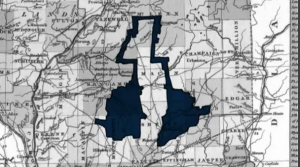Gerrymandering as a Threat to Democracy
A large portion of Chapter 11 was devoted to talking about representation in Congress, and specifically how Gerrymandering affects this representation. Gerrymandering is the redrawing of electoral district lines in an extreme and unlikely manner to give an advantage to a particular party or candidate. This redistricting is often managed by state legislatures who are relatively free to draw district lines however they choose. To pull off an effective gerrymander, a legislature usually uses two tactics called “cracking” and “packing”. Cracking spreads one party’s voters across multiple districts effectively denying them a majority in any single district. Packing puts voters of the rival party into one district which gives the rival party a huge margin of support in one district but cuts its chances of winning seats in multiple districts. For example, the Illinois 4th district is nicknamed “the earmuffs” because it connects two predominantly Latino areas by a thin line that is effectively just one road. In doing so, it packs Democrats into a contorted district, ensuring that those voters cast ballots in a safely Democratic preserve. The net result is a weakening of the power of Latino votes and more Republican districts. Because Democrats are packed together as tightly as possible in district, Republicans have a chance to win surrounding districts even though they are vastly outnumbered geographically.

Gerrymandering is thought to reduce political competition within districts, perpetuate the tenure of incumbents, and create legislative majorities in state legislatures and in the House of Representatives that do not reflect the views of the majority of citizens. All of these effects of Gerrymandering distort American democracy and circumvents the principle of one vote, one person that underlies our Democracy. In the 2016 elections for the House of Representatives, only 17 seats out of 435 races were decided by a margin of 5% or less. 33 seats in total were decided by a margin of 10% or less. In other words, more than 9 out of 10 House races were landslides where the campaign was a foregone conclusion before ballots were even cast. There was no true competition in these Congressional races and that is not healthy for a system of government that, at its core, is defined by political competition. The decline in the number of competitive districts in the House elections means that the vast majority of districts in the US are safely Republican or safety Democratic where candidates need not appeal to the general constituency but only to members of their party, contributing to the ever-deepening partisan divide in Congress.
However, gerrymandering is embedded in the Constitution that expressly assigns power to each state to prescribe its own redistricting rules, and proponents would argue that gerrymandering simply reflects the basic human instinct for people to join groups that reflect their own interests and identity. Instead of abandoning gerrymandering, why not use it to achieve a different objective—to create as many competitive districts as possible? This would address several issues simultaneously like reduce the number of representatives who are permanent fixtures in Washington, increase voter participation, weaken the influence of special interests, and provide incentive for compromise in Washington.
https://www.washingtonpost.com/news/democracy-post/wp/2017/02/10/gerrymandering-is-the-biggest-obstacle-to-genuine-democracy-in-the-united-states-so-why-is-no-one-protesting/?utm_term=.e4983a9438aa